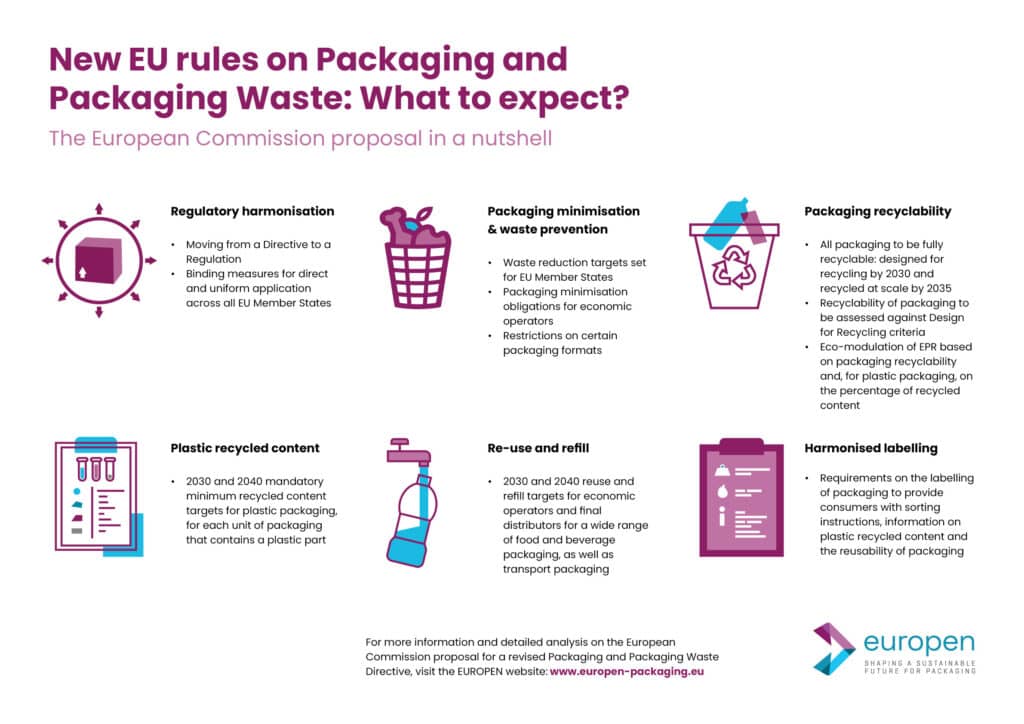2.2.2 Showcase of Innovative Packaging Solutions
On July 2nd 2014, in the framework of the “circular economy package”, the European Commission adopted a legislative proposal to review recycling and other waste related legislation, including the PWPD. The aim of the proposal is to help turn Europe into a circular economy with packaging playing a major role: recycling and preparing for the re-use of packaging waste is expected to be increased to 80 % by 2030, with material-specific targets set to gradually increase between 2020 and 2030 and to reach 90 % for paper by 2025 and 60 % for plastics, 80 % for wood, and 90 % for ferrous metal, aluminum and glass by the end of 2030.
Here are some examples of sustainable and smart packaging solutions:
- Biodegradable and compostable materials: Packaging made from biodegradable materials, such as plant-based plastics (PLA), cellulose, or bio-based films, can break down naturally in the environment without leaving harmful residues. Compostable packaging can be processed in industrial composting facilities, reducing waste and promoting a circular economy.
- Recycled and recyclable packaging: Using recycled materials for packaging reduces the demand for new resources and helps divert waste from landfills. Additionally, designing packaging that is easily recyclable and clearly labeled with recycling instructions encourages consumers to participate in recycling programs.
- Minimalist packaging: Streamlining packaging design by eliminating unnecessary layers, reducing overall material usage, and optimizing package sizes reduces waste and environmental impact. By focusing on the essentials, minimalist packaging solutions help conserve resources and reduce carbon emissions during transportation.
- Smart packaging: Incorporating technology into packaging can enhance functionality and reduce waste. For example, smart labels and sensors can provide real-time information about product freshness, temperature, or tampering, reducing food waste and ensuring product quality. Smart packaging can also enable interactive experiences, such as augmented reality (AR) labels that engage consumers and provide additional product information.
- Renewable and sustainable energy sources: Packaging can be designed to incorporate renewable energy sources, such as solar panels or kinetic energy generators, to power embedded sensors or LED displays. This reduces reliance on traditional energy sources and promotes sustainable practices.
- Lightweight and space-efficient designs: Optimizing packaging for efficient use of space and reducing weight helps minimize transportation costs and carbon emissions. Lighter packaging materials and designs also reduce the amount of waste generated.
- Returnable and reusable packaging: Implementing systems where packaging can be returned, cleaned, and reused reduces the need for single-use packaging. This approach is commonly used in industries such as beverage or shipping, where returnable containers are collected, sanitized, and reused.
- Intelligent logistics and supply chain management: Employing advanced data analytics and tracking technologies in packaging can optimize supply chain operations, reduce fuel consumption, and minimize waste. Smart packaging solutions can help monitor inventory, improve routing efficiency, and enhance overall logistics processes.
These are just a few examples of sustainable and smart packaging solutions. As technology advances and environmental concerns continue to grow, innovative solutions will continue to emerge to address the challenges of packaging waste and environmental impact.

Figure 3- European Commission
Proposal for the Revision of the Packaging and Packaging Waste Directive.